Posted: July 1st, 2012 | 2 Comments »
I’m eager to promote this great little book from an old friend Mark O’Neill about his grandfather who was an Irish Presbyterian missionary in Manchuria. I’m also aware that missionary biographies are not a genre much previously favoured on China Rhyming but Mark is a superb journalist and story teller, has worked long and hard on this book and also tracked down his grandfather’s old Chinese medals (which I have blogged about previously). The problem is that, outside of bookshops in Hong Kong, I’m not quite sure how you can order this book from Joint Publishing (HK). Perhaps better internet searchers than me can find a way.
A much more detailed review of the book is here at the Asia Sentinel

Posted: July 1st, 2012 | No Comments »
Regular readers will know I am a great lover of famous men (and it is all men so far I’m afraid but submissions are open from all periods and genders) making comparisons between China and other places (invariably provincial England). Here is a round up of the best so far:
- The usually erudite and brilliant W Somerset Maugham wrote ‘…the bamboo, the Chinese bamboo, transformed by some magic of the mist, look just like the hops of a Kentish field’;
- The American comedian Will Rogers compared the countryside around Harbin to Nebraska when he visited in the early 1930s;
- In the 1870s Jules Verne compared Hong Kong to a town in Kent or Surrey;
- In 1933 Peter Fleming toured China and compared Chengde to Windsor;
- He then compared Peking with Oxford for some reason! – gotta love the Flemster!!;
- Later in 1938 Auden and Isherwood described the countryside around Canton (Guangzhou) as reminiscent of the Severn Valley;
- And then during his stay in China during the Second World War the (yet to be at the time) famous Sinologist Joseph Needham compared Fuzhou to Clapham and, perhaps most bizzarely, wartime Chongqing to the charming Devon seaside resort of Torquay!
And here’s two new additions –
I’d forgotten Noel Coward’s excellent comparison of 1921 Shanghai as ‘a cross between Brussels and Huddersfield’
Then there’s EM Forster’s science fiction short story from 1909 called The Machine Stops where he writes, ‘What was the good of going to Peking when it was just like Shrewsbury? Why return to Shrewsbury when it would all be like Peking?’
Two worthy editions I think you’ll agree…
 Huddersfield back then – could it have been just a “reet grim” up Shanghai way in 1921??
Huddersfield back then – could it have been just a “reet grim” up Shanghai way in 1921??
 Behold the lovely old market town of Shrewsbury…errr, in olden times…a dead ringer for Peking I’m sure we can all agree
Behold the lovely old market town of Shrewsbury…errr, in olden times…a dead ringer for Peking I’m sure we can all agree
Posted: June 30th, 2012 | No Comments »
Given my recent comments on dragon ladies (see Foreign Policy article here) I thought perhaps a little biography of Dragon Lady-related books was in order – not exhaustive and do feel free to add…
The Asian Mystique: Dragon Ladies, Geisha Girls and the Fantasies of the Exotic Orient – Sheridan Prasso
Dragon Lady: The Life and Legend of the Last Empress of China – Sterling Seagrave
The Dragon Empress – Marina Warner
Decadence Mandchoue – Edmund Backhouse
China Under the Empress Dowager – Edmund Backhouse & JOP Bland
The Last Empress – Anchee Min
The Last Empress: Madame Chiang Kai-shek and the Birth of Modern China – Hannah Pakkula
Madame Chiang Kai-shek: China’s Eternal First Lady – Laura Tyson-Li
Madame Mao: The White Boned Devil – Ross Terrill
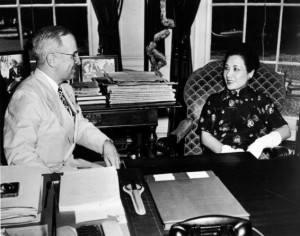
Madame vamping Truman in her white gloves and trademark qipao
Posted: June 29th, 2012 | No Comments »
As I’m on about the various Chinese bits and pieces of interest in the Museum of London then, though I’m a couple of months late, I have to note this great illustration of the Chinese community celebrating tomb sweeping day (qingming) in London. The illustration below is from the Illustrated London News for April 24th 1909. It shows Chinese in England attending to graves in the “East London Cemetery” (which is still in use out in Plaistow). The Chinese gravestones are interesting (not sure if any are still there? – I’ve never been over to Plaistow, the esteemed ancestors of the French family are all gathered either in North London “crems” or long gone Whitechapel graveyards) and suckling pig is elaborate as well as whisky. The illustration seems to indicate that the curious English found this interesting. The Chinese mens costumes of labouring jackets and flat caps seem accurate from pictures of Limehouse at the time. More details here.
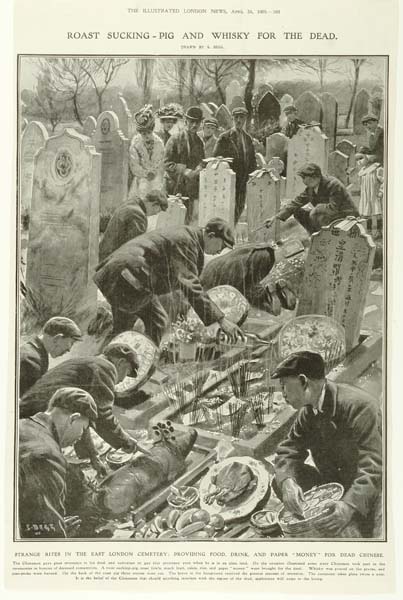
Posted: June 29th, 2012 | No Comments »
I’ll just a list of UK media reviews up for the record and in case anyone’s interested.
Of course The Economist is a biggie
The Scotsman went on at great length and very nicely too
The Sunday Express liked the writing as well as the story, so no complaints this end
The Daily Telegraph was fine too
The Spectator (who like everyone has used the picture of Pamela which is nice to see everywhere)
The Financial Times were great too
Scotland on Sunday was fine as well
and then finally the Guardian reviewed too…
And here’s WH Smith’s at Heathrow where the Queen still rises above me!!

Posted: June 28th, 2012 | No Comments »
Perhaps not the most gripping and scintillating read of the year but perhaps useful for background research…
Gavin Ure
Royal Asiatic Society Hong Kong Studies Series
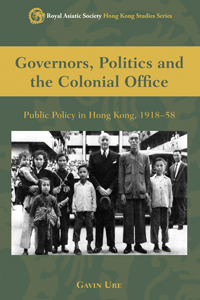
This book explores the making of public policy for Hong Kong between 1918 and 1958. During much of this period, the Hong Kong government had limited policymaking capabilities. Many new policies followed initiatives either from the Colonial Office or from politicians in Hong Kong. This book examines the balance of political power influencing how such decisions were reached and who wielded the most influence—the Hong Kong or British governments or the politicians. Gradually, the Hong Kong government, through implementing new policies, improved its own policy-making capabilities and gained the ability to exercise greater autonomy.The policy areas covered by this book include the implementation of rent controls in 1922, the management of Hong Kong’s currency from 1929 to 1936, the resolution of the financial dispute over matters arising from World War II, the origins of Hong Kong’s public housing and permanent squatter resettlement policies, negotiations over Hong Kong’s contribution to its defence costs and the background to the granting of formal financial autonomy in 1958.
Governors, Politics and the Colonial Office will be of interest to historians and political scientists, and to anyone with a general interest in the social, economic and political development of Hong Kong.
Gavin Ure is a former Administrative Officer with the Hong Kong government. He is now Adjunct Associate Professor in the Department of Applied Social Science at the Hong Kong Polytechnic University.
“In this meticulously researched book, based on archival sources, Gavin Ure explores the important issue of how Hong Kong’s colonial rulers made public policy. Through a careful examination of key political, economic and social questions, he shows how local administrators were able to wrest autonomy from the British government and to run the colony on their own terms. The book is essential reading for anyone interested in Hong Kong’s history and the policies that have shaped the modern city.” — Ian Scott, author of The Public Sector in Hong Kong
“Who governs Colonial Hong Kong—London or the officials sent from Britain? The issue of autonomy is central to our understanding of politics and policymaking in Hong Kong during the colonial era. From a unique perspective, both as an academic and former senior civil servant, Gavin Ure demonstrates how Hong Kong gradually gained control of key areas of public policy. This book is an essential read for anyone with an interest in politics and public policy in Hong Kong.” — James Lee, Hong Kong Polytechnic University
Posted: June 28th, 2012 | 1 Comment »
…a piece I did for Foreign Policy on dragon ladies that was fun. And, just before everyone piles in, I am aware that “dragon lady” was originally a western construct (I almost sound like an academic there!) going back to the Terry and the Pirates comic strip and Yellow Peril novels. However, it is interesting that it is also now used in China pretty widely. Anyway, here’s my quick summary in the word count allowed…a dash though an empress, an empress dowager, Madame’s Chiang, Mao and others right up to Madame Gu!
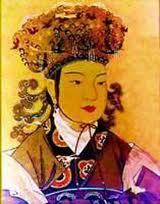 the Empress Wu – trashed by the Confucians!
the Empress Wu – trashed by the Confucians!
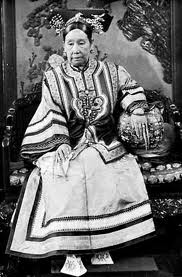 Dowager Empress Ci Xi – poisoned cakes to take over
Dowager Empress Ci Xi – poisoned cakes to take over
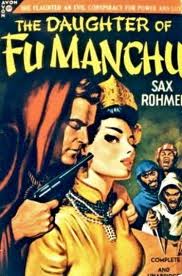 Bad girl, bad dad…
Bad girl, bad dad…
 Madame Chiang – who even vamped Churchill!
Madame Chiang – who even vamped Churchill!
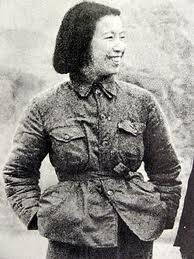 Madame Mao – not a lot of redeeming features here I’m afraid
Madame Mao – not a lot of redeeming features here I’m afraid
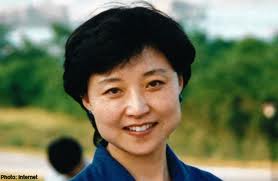 Madame Gu – a dragon lady for the 21st century?
Madame Gu – a dragon lady for the 21st century?
Posted: June 27th, 2012 | No Comments »
A quick post to link to a paper given by Ho Yin Lee (Programme Director, Architectural Conservation Programme at The University of Hong Kong) and Lynne DiStefano of HKU’s Architecture Department on conservation in Hong Kong. It was presented as part of the LSE Cities Conference. Some interesting stuff – here’s a paragraph…I really wish I had time to do the course in conservation!!

For the authors, as faculty members of China’s first and only master degree level academic programme in conservation – the Architectural Conservation Programme at the University of Hong Kong – we are pleased to see that built-heritage conservation is no longer considered an obscure branch of studies lumped together with museums and antiquities. What the programme has been advocating, that urban conservation should be an essential component of the sustainable development of Hong Kong as a city, has finally been given its due recognition. Many of the principles and ideas taught and advocated in the programme have become widely discussed not only in academic circles but also by the public through the mass media. When the programme was first established in 2000, the common reaction was, ‘What’s there to conserve in Hong Kong?’. Now, the common response is, ‘There is so much we need to conserve in Hong Kong, and we’re not doing enough’. For the loss of the Star Ferry Pier and Clock Tower, Hong Kong has gained one small step in the sustainable development of the city, and a significant step in the continual effort for better urban conservation and improved quality of life.













